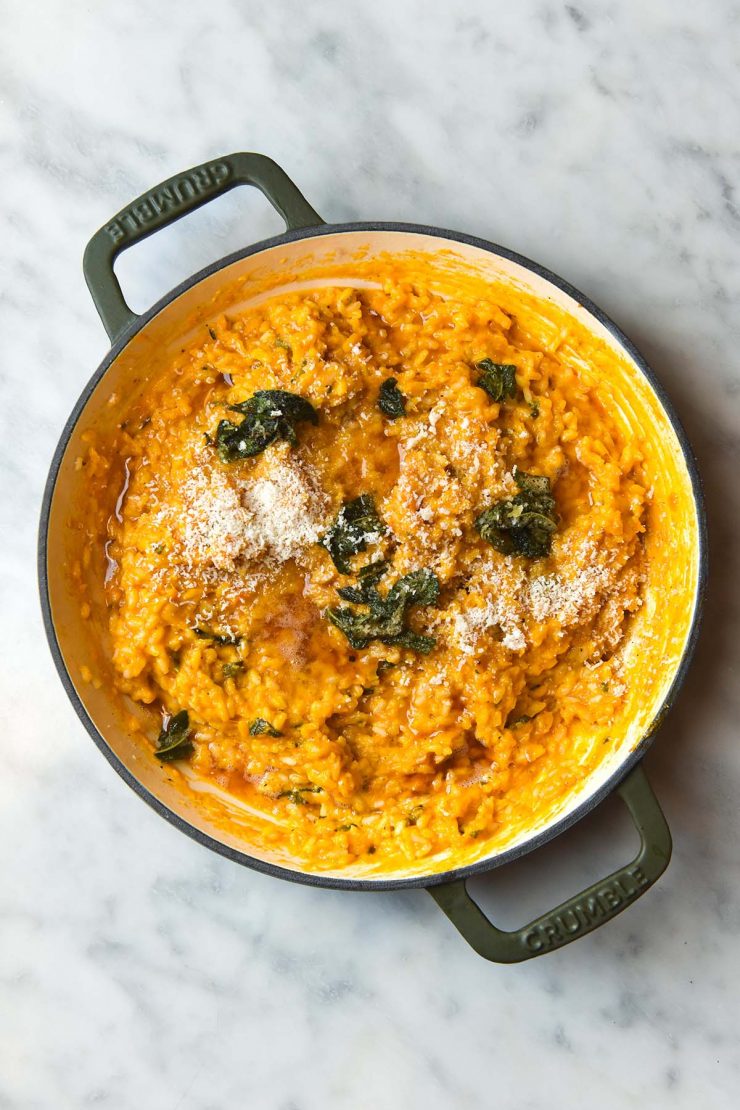
The risotto bender continues! Buoyed by my newfound interest in and love of risotto, I have been experimenting with different flavours. On the menu today: this creamy and delicious pumpkin risotto with sage. It’s the perfect autumn or winter dish that is comfort food at it’s finest.

Pumpkin risotto with sage (low FODMAP)
This pumpkin risotto is low FODMAP and is made without garlic. Well, kind of – I use garlic infused ghee to give it a rich and garlicky taste without the FODMAP content. It uses Japanese or Kent pumpkin puree to keep the FODMAP content low, as well as low FODMAP stock or stock powder. The risotto is finished off with a hearty quantity of parmesan for a cheesy, delicious finish.
Risotto is made from Arborio or Carnaroli rice, so it is naturally gluten free. This risotto is also vegetarian if you use a parmesan without animal rennet. If you are based in Australia, see my list here of vegetarian parmesan brands available (yes, they exist).
FODMAP notes for your pumpkin risotto
These FODMAP thresholds are current as of September 2025. They will be periodically reviewed to ensure they remain up to date with FODMAP research.
Choose Japanese or Kent pumpkin for a lower FODMAP alternative to butternut. Monash have semi-recently (as of November 2024) lowered the threshold for Japanese/Kent pumpkin. It is low FODMAP in 75g serves and up to 161g serves per person. In 162g serves, it contains moderate amounts of fructans. It is still the pumpkin variety that you can eat most of on the low FODMAP diet, according to Monash. Another thing to keep in mind is that you don’t need to change anything if you have been eating pumpkin without issue prior to this change.
Interestingly, FODMAP Friendly app lists Grey pumpkin (Queensland Blue) as low FODMAP in serves of up to 214g. Something to consider if you react to Kent pumpkin.
My garlic ghee recipe was developed by me to be a low FODMAP alternative to garlic butter. Because ghee is not 100% fat, there is a tiny risk of some fructan (which is fat soluble) leeching into the ghee. I daresay it would not be enough to cause symptoms ever, but it’s worth noting. You could also experiment with pickled garlic, which is a newer low FODMAP ingredient.
Be sure to choose a low FODMAP stock. There are some stock cubes available in Australia that are low FODMAP under Massell brand. I have a recipe for low FODMAP vegetable stock here.
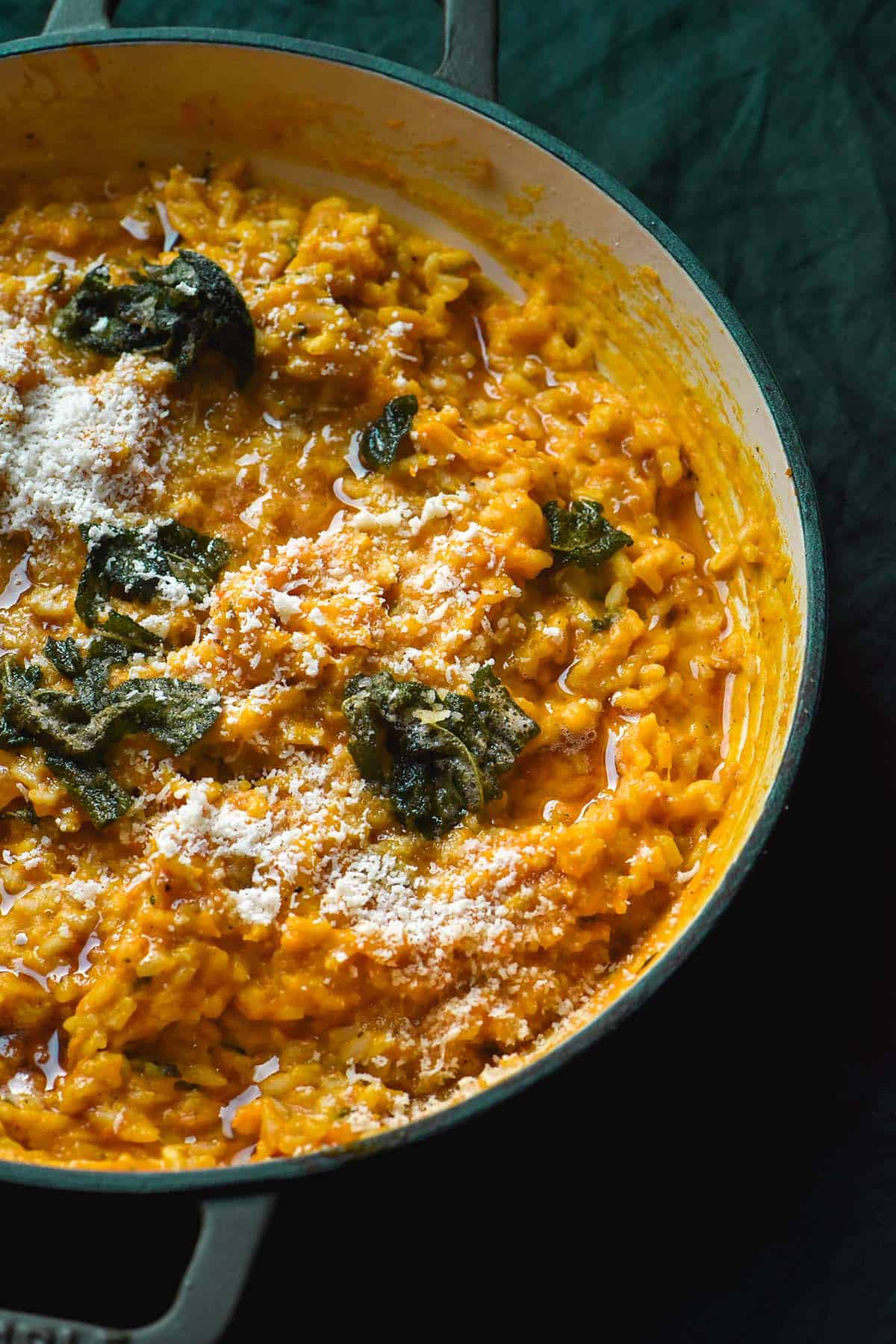
Can I make this pumpkin risotto without white wine?
Yes, you can. Although I do feel that white wine adds a beautiful depth of flavour to risotto, you can omit it if you prefer. Simply use stock or water in place of the wine. I do recommend adding extra lemon juice or vinegar to replace some of the acidity for a perfectly balanced risotto, though.

Can I make this pumpkin risotto vegan?
I haven’t tried this yet! I daresay it would be fine, but I recommend adding the vegan parmesan to taste. Vegan parmesan works quite differently to regular parmesan in terms of thickening. It can also taste quite strong (or not) so add it according to the brand you’re using and your tastes.
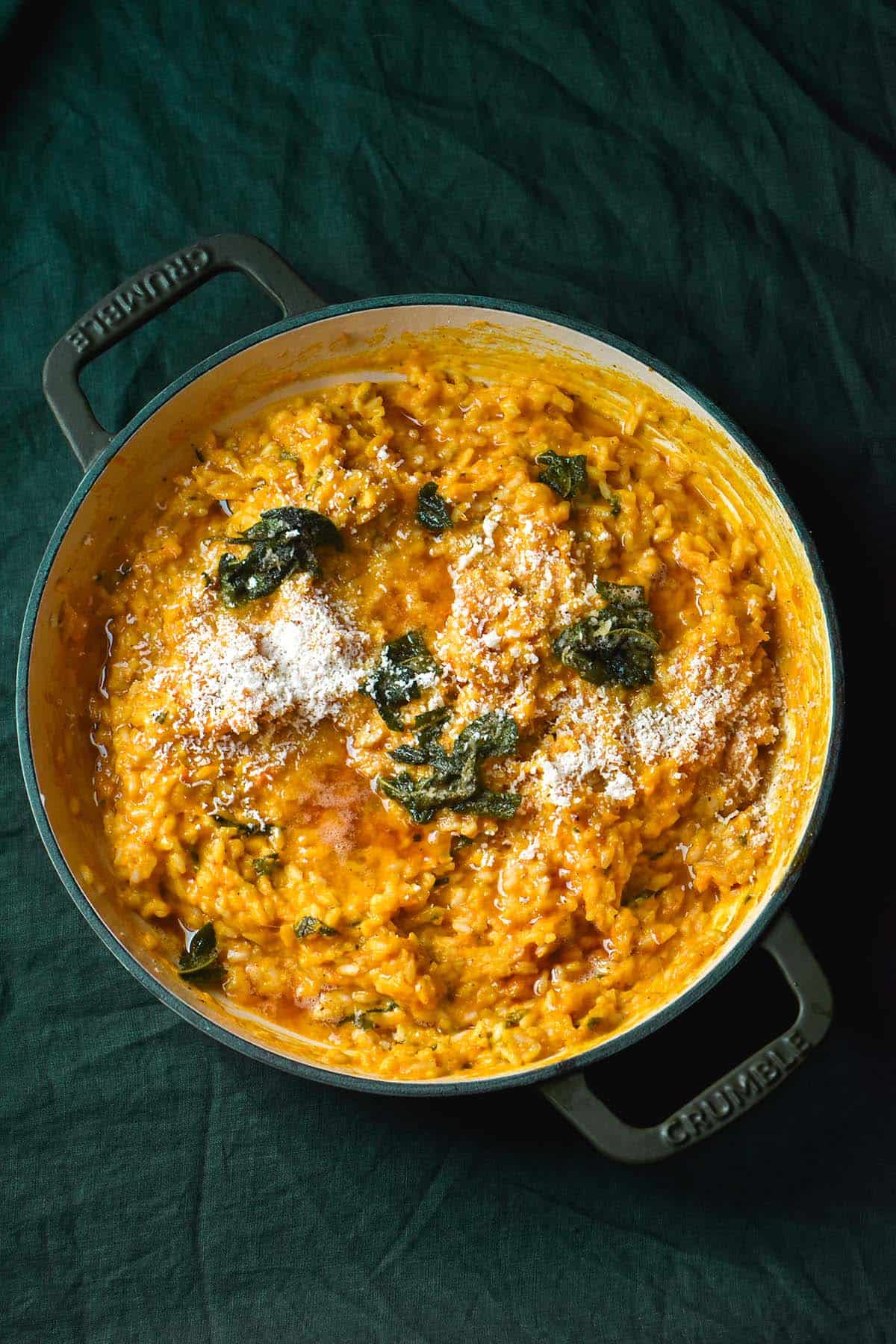
Can I used canned pumpkin puree?
Although canned pumpkin puree is not common here in Australia, I wanted to address this for my American readers. I have not ever used pumpkin puree from a can, but other sites use it in their pumpkin risotto recipes. So, I would say yes.
A few things to consider, though: Firstly, make sure you use plain pumpkin and not pumpkin pie spiced. Secondly, add the puree heated, or factor in time to reheat the risotto after adding it. Make sure to season the risotto to taste after adding the pumpkin and parmesan.
Different ways to add pumpkin to this pumpkin risotto
I have tested a number of different methods for adding pumpkin to this risotto. They are:
Adding raw, grated pumpkin to the risotto after the white rice is added. I found this method a bit unnerving to begin with as it felt it was going to take forever. However, it did work.
Adding roasted, mashed pumpkin. I chopped the pumpkin into bite sized pieces and roasted it in oil for about 45 minutes. I then mashed the pumpkin on the tray and added it to the pumpkin. Honestly, I didn’t taste a huge difference between this and other batches. I’d also recommend keeping in mind that you’ll either need to reheat the risotto once the puree is added, or heat the puree prior to adding it.
Finally, I made pumpkin puree in the microwave. To do this, I added small cubes of pumpkin to a medium/large heat proof bowl and microwaved it for 5 minutes. I then stirred it, allowed it to steam in the microwave and then microwaved for another 3-5 minutes. A quick mash (or blend) of the pumpkin and you’re good to go.
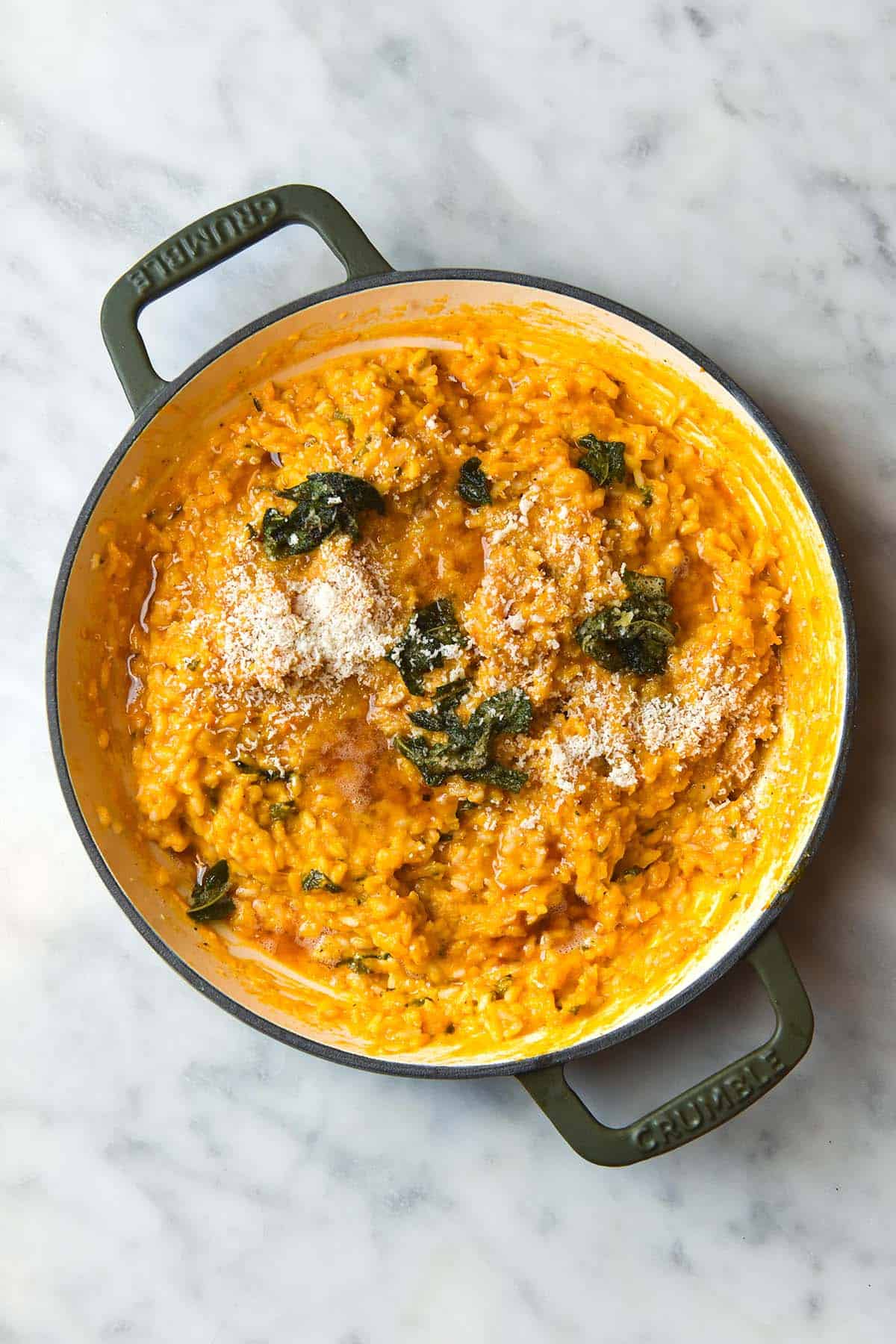
Tips for making risotto
- Cook the risotto grains for 3-4 minutes in the ghee or oil. Toasting the grains without liquid first will help ensure the grains keep their shape during cooking.
- Keep the stock on a very low heat in a pot alongside your risotto. Adding hot liquid encourages the starches in the rice to come out, which is what creates a creamy risotto. Further than that, cold stock will increase the cooking time. No thanks.
- Add liquid to suit your risotto. No two risottos will be the same. Continue to intermittently stir, cook add liquid until the grains are cooked through but have a bit of bite. If you run out of stock, use water. Keep in mind here that we are adding 500g of pumpkin puree at the end, so your risotto can be a little thicker than you like it prior to adding the pumpkin.
- Add your final ingredients off the heat. I like to add the pumpkin puree first here, then the cheese. As you’ll know if you’ve made cacio pepe, parmesan can overcook and become stringy. Adding the cold puree helps to bring the temperature down before adding the cheese.
- Parmesan will help bring your risotto together. If it’s looking a little runny after adding the puree, don’t stress. The parmesan will create a cohesive, thick risotto that stands up in the bowl.
- Taste and adjust the seasoning before plating. Pepper, salt and lemon juice are all individual preferences, so add them to yours.
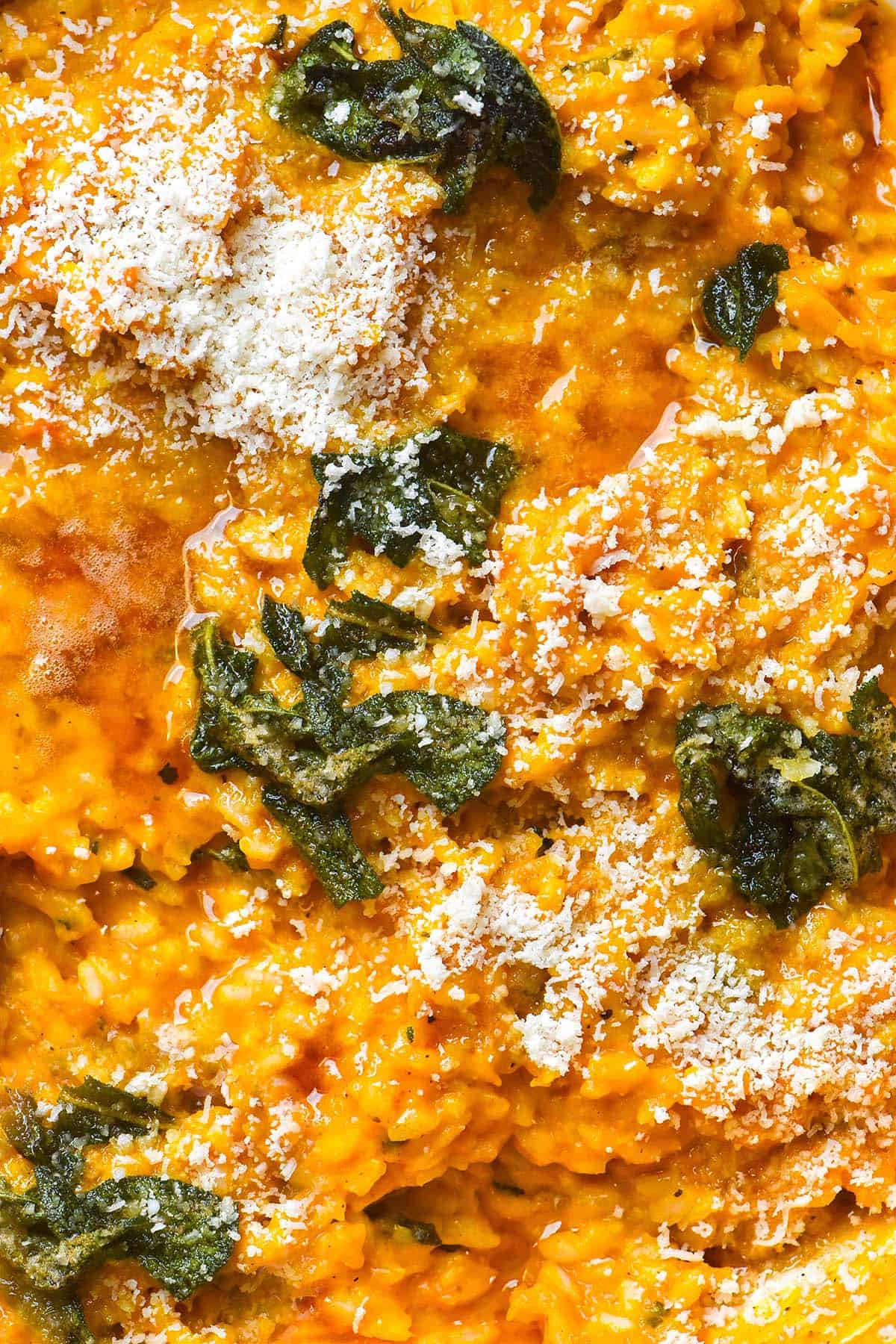
More low FODMAP Italian inspired recipes
- Low FODMAP risotto verde
- Cacio e pepe risotto
- Low FODMAP pasta sauce
- Vegan, low FODMAP and gluten free lasagne
- Gluten free, low FODMAP tiramisu
- Low FODMAP mushroom and leek risotto
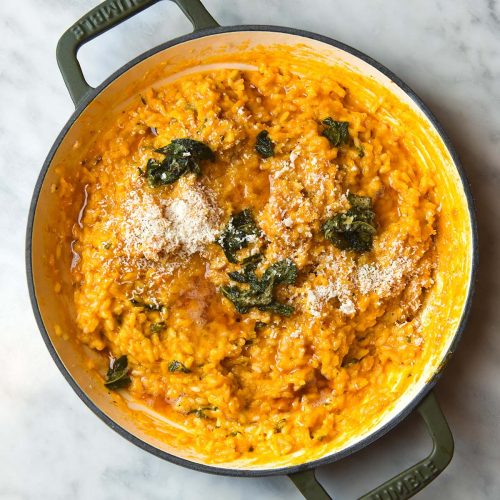
Pumpkin risotto (low FODMAP)
Ingredients
For the risotto:
- 500-600 g Japanese or Kent pumpkin roasted and pureed, steamed and pureed or raw and grated (see notes)
- 1-2 tablespoons garlic infused ghee see notes for recipe link
- 20 g fresh sage use divided, woody stems removed and roughly chopped
- 300 g Arborio or Carnaroli rice
- 125-150 ml dry white wine (optional, see body of post)
- 750-1000 ml low FODMAP stock (see notes)
- 100 g freshly and finely grated Pecorino Romano or Parmesan (vegetarian if need be, see notes)
- ground nutmeg to taste
- Plenty of seasoning to taste
- Lemon juice to taste
- Extra grated parmesan to finish
For the brown sage butter (optional):
- 75 g butter browned
- 10 g sage leaves woody stems removed and roughly chopped
Instructions
To make the risotto:
- Place a large pan or pot over a medium heat and add the ghee. Once it is melted and shimmering, add the rice grains and sage. If you don’t intend to finish the risotto with the brown sage butter, add all the sage here. If you do, reserve half for the brown butter.
- Cook for 3-4 minutes or until the rice grains start to become a little bit translucent.
- Once the grains are toasted, add the white wine to the pan. Stir and allow it to be absorbed by the grains. Once absorbed, add a ladle full of warm stock. Stir gently and allow the stock to be absorbed by the grains. Repeat this process until you have used 750ml of stock. From here, assess: is the rice cooked through but firm? Are there any undercooked grains? Does the risotto have a creamy, saucy texture without being sloppy? Add the extra stock, if necessary, to achieve this consistency.
- Once you’re happy with the consistency, take the risotto off the heat. Stir in the warm pumpkin puree. Next, stir in the cheese in batches, adding a splash of extra stock if necessary to achieve a creamy risotto that still holds its shape. Add the nutmeg to your tastes. Add plenty of seasoning (this will depend on how salty your stock is) plus lemon juice to taste.
- Serve with the sage butter drizzled over the top or with a sprinkling of parmesan and pepper. Leftovers keep well in the fridge for a couple of days.
To make the brown sage butter:
- Brown the butter in a frypan over a medium heat. Once nutty and medium brown, add the sage leaves and cook for a minute or two until they start to shrivel. You can cook them until crispy or leave them slightly undercooked for a bit of green.
Notes
- The recipe for garlic infused ghee can be found here.
- You can find my Low FODMAP vegetable stock recipe here.
- Monash have semi-recently (as of November 2024) lowered the threshold for Japanese/Kent pumpkin. It is low FODMAP in 75g serves and up to 161g serves per person. In 162g serves, it contains moderate amounts of fructans. It is still the pumpkin variety that you can eat most of on the low FODMAP diet. Another thing to keep in mind is that you don’t need to change anything if you have been eating pumpkin without issue prior to this change.
- If you use 500g pumpkin in this risotto, that equates to 125g pumpkin per serve. This still keeps you within a low FODMAP threshold. If you use 600g pumpkin, that equates to 150g pumpkin per serve. This is still just under a low FODMAP threshold.
- You have three options for adding pumpkin to this risotto. They are:
- 1) Adding raw, grated pumpkin to the risotto after the white rice is added. I found this method a bit unnerving to begin with as it felt it was going to take forever. However, it did work.
- 2) Adding roasted, mashed pumpkin. I chopped the pumpkin into bite sized pieces and roasted it in oil for about 45 minutes. I then mashed the pumpkin on the tray and added it to the pumpkin. Honestly, I didn’t taste a huge difference between this and other batches. I’d also recommend keeping in mind that you’ll either need to reheat the risotto once the puree is added, or heat the puree prior to adding it.
- 3) Finally, adding pumpkin puree made in the microwave. To do this, I added small cubes of pumpkin to a medium/large heat proof bowl and microwaved it for 5 minutes. I then stirred it, allowed it to steam in the microwave and then microwaved for another 3-5 minutes. A quick mash (or blend) of the pumpkin and you’re good to go.
- If you have access to canned pumpkin, I daresay this would also work.

Hi George, Can you substitute garlic infused olive oil for garlic infused ghee please?
Hi Leslie, absolutely! Garlic infused oil will work nicely here too 🙂